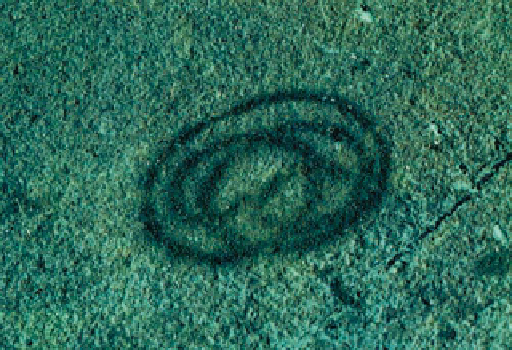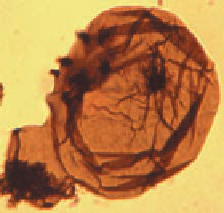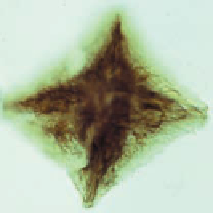Geology Reference
In-Depth Information
invertebrate phyla are represented: jellyfi sh and sea pens
(phylum Cnidaria), segmented worms (phylum Annelida),
and primitive members of the phylum Arthropoda. One
wormlike Ediacaran fossil,
Spriggina,
has been cited as a
possible ancestor of trilobites, and another
Tribachidium,
may be a primitive echinoderm (Figure 19.26 a, b). On
the other hand, some think Ediacaran fossils represent an
early evolutionary radiation distinct from the ancestry of
existing invertebrates. These
Ediacaran faunas
existed be-
tween 670 and 570 million years ago and are now known
on all continents except South America and Antarctica.
The animals were widespread, but their fossils are not very
common because all of them lacked durable skeletons.
Other Proterozoic Animal Fossils
Although scarce, a
few animal fossils older than those of the Ediacaran fauna
are known from Neoproterozoic rocks (
◗
Figure 19.22
Paleoproterozoic Fossil This fossil, known as
Grypania
, may be some kind of algae. It is from the 2.1-billion-year-old
Negaunee Iron Formation at Marquette, Michigan.
Figure 19.26). A
jellyfish-like impression is present in rocks 2000 m below
the Pound Quartzite, and in many areas, burrows, presum-
ably made by worms, are found in rocks at least 700 million
years old. Wormlike fossils, as well as fossil algae, come
from 700- to 900-million-year-old rocks in China, but the
identity and age of these “fossils” have been questioned.
All known Proterozoic animals were soft-bodied, but
there is some evidence that the earliest stages in the origin of
skeletons were underway. Even some Ediacaran animals may
have had a chitinous carapace, and others appear to have
had areas of calcium carbonate. The odd creature known as
Kimberella
, from the latest Proterozoic of Russia, had a tough
outer covering similar to that of some present-day marine
invertebrates (Figure 19.26c). Exactly what
Kimberella
was
remains uncertain; some think that it was a mollusk.
Neoproterozoic fossils of minute scraps of shell-like
material, as well as small toothlike denticles and spicules,
presumably from sponges, indicate that several animals with
skeletons or at least partial skeletons existed. But more durable
skeletons of silica, calcium carbonate, and chitin (a complex
organic substance) did not appear in abundance until the
◗
organisms give some clues about how this transition might
have taken place.
Suppose that a single-celled organism divided and
formed a group of cells that did not disperse, but remained
together as a colony. The cells in some colonies may have be-
come somewhat specialized, similar to the situation in some
living
colonial organisms.
Further specialization might have
led to simple multicelled organisms such as sponges, con-
sisting of cells that carry out functions such as reproduction,
respiration, and food gathering. Carbonaceous impressions
of Proterozoic multicelled algae are known from many
areas.
The Ediacaran Fauna
In 1947, the Australian geologist
R. C. Sprigg discovered a unique assemblage of multi-
celled, soft-bodied animals preserved as molds and casts
on the undersides of sandstone layers (
Figure 19.25).
Some investigators think that at least three present-day
◗
◗
Figure 19.23
Proterozoic Fossils These are probably from eukaryotic organisms and measure only
40 to 50 microns across.
b
This acritarch, known as
Octoedryxium truncatum
,
was found in Neoproterozoic
rocks in Sweden.
c
This vase-shaped
microfossil from Neoproterozoic
rocks in the Grand Canyon in
Arizona is also a cyst from
some kind of algae.
a
The acritarch
Tappania
piana
is from Mesoproterozoic
rocks in China.







Search WWH ::

Custom Search